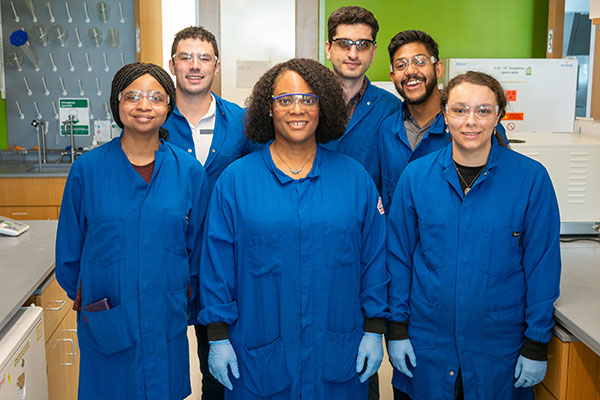Spark Fund Award Research to Address Atherosclerosis

ChE/BioE Associate Professor Eno Ebong is using a Spark Fund award from the Center for Research Innovation at Northeastern to develop a novel therapeutic that targets the glycocalyx to prevent atherosclerosis, a cardiovascular disease that can lead to secondary cardiovascular events such as strokes or heart attacks.
A Novel Approach to Fighting Atherosclerosis — with Spark Fund Awardee Professor Eno Ebong
Atherosclerosis, or plaque formation in the arteries, is a cardiovascular disease that can lead to secondary cardiovascular events, such as strokes or heart attacks. Cardiovascular events are the leading causes of death worldwide, and cardiovascular disease affects 121 million American adults. Therefore, many researchers are dedicated to developing innovative therapeutic approaches to counteract this devastating disease. One such researcher is Northeastern Professor Eno Ebong, Ph.D.
Prof. Ebong and her team are developing the first novel preventative therapeutic that targets the glycocalyx, a sugar-chain structure that protects vascular endothelial cells and plays a role in the development of cardiovascular disease. This work has earned them selection as one of the Fall 2023 Spark Fund awardees.
A Novel Approach: Glycocalyx’s Role in Atherosclerosis
Ebong and her team have been dedicated to this research since 2016, after an accidental discovery in Ming Cheng’s and Solomon Mensah’s lab. Today, the team consists of three other Northeastern researchers: Ron Mitra, a PhD student in chemical engineering, Kaleigh Pentland, a post-baccalaureate in bioengineering, and Arthur J Coury, University Distinguished Professor in the Department of Chemical Engineering.
The team is focused on glycocalyx because atherosclerosis coincides with inner blood vessel endothelium shedding its protective glycocalyx coat. Glycocalyx loss disables endothelium function and protection against unwanted molecular and cellular infiltration from the flowing blood. In other words, glycocalyx damage is the first step of atherosclerosis. Therefore, focusing on the glycocalyx can help with early discovery of the disease.
Many existing atherosclerosis prevention and treatment measures use lipid-lowering and anti-platelet drugs. Despite these treatments, the disease remains a tremendous burden worldwide. Therefore, treatments that clinically restore endothelium glycocalyx could treat vascular disease earlier and minimize the disease burden.
Ebong’s research aims to regenerate the endothelium glycocalyx, reverse endothelium dysfunction, and hinder atherosclerosis development using a novel, biologically derived treatment containing a bioactive lipid mediator or its derivatives. Today, the team is optimizing the therapeutic formulation to ensure the greatest efficiency.
Through the Center for Research Innovation (CRI), the team filed for a provisional patent. The team previously received Tier-1 funding from the Provost. Currently, the in vitro work is funded through an NIH R03 grant, and the team hopes to receive a major NIH R01 grant in the future.
Commercialization with the Spark Fund
The Spark Fund Award given by Northeastern’s Center for Research Innovation will help Ebong’s team progress their research through preclinical animal data and acquire funding for future stages.
“The Spark Fund will be instrumental in helping us advance our research goals,” says Ebong. “This will be the first time we will apply our therapeutic in an in vivo setting, as all our previous work was conducted in our in vitro model. Acquiring this preclinical animal data will allow us to file for a patent and apply for federal funding to move the project forward.”
Within the next several years, the team is working to get the technology reduced to practice in cell culture and small animal models. Following these milestones, the team will begin to determine the preclinical efficacy, pharmacokinetics, safety, and toxicity using large animal models. When looking forward to drug delivery, the team is interested in exploring creative solutions, such as nanoscale drug carriers, oral tablets, coated stents, or intravenous injection following surgery and trauma. Ideally, the team would like to reach the goal many researchers strive for: clinical trials, FDA approval, and licensing to pharmaceutical companies and vascular implant.
“Overall, it was a smooth process applying for the Spark fund,” says Ebong. “The CRI Spark Fund team provided great feedback on our application.” The feedback and guidance from the CRI helped the team reframe their approach in a way that will help them progress their research and optimize their chance of commercialization success going forward.
“The commercialization journey forces me to look at my research differently than I was trained to look at it,” says Ebong. “To succeed in a commercial setting, the research has to solve a relevant problem and be significantly better than prior solutions. The financial cost-benefit analysis has to be carefully considered along with clinical feasibility. I appreciate the perspective from the CRI as I anticipate it will lead to this work having a greater impact.”
Source: Center for Research Innovation